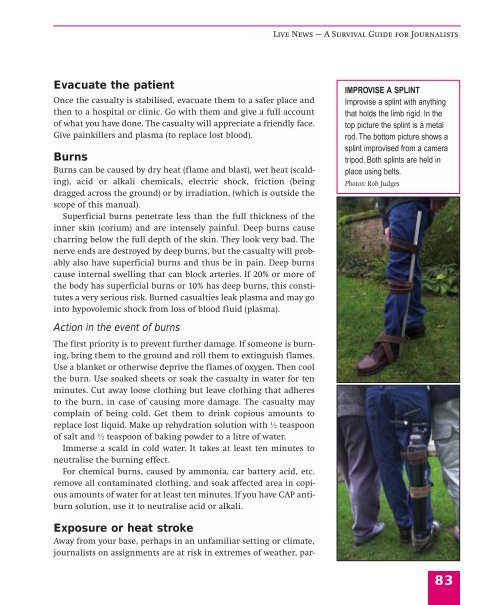Live News - A Survival Guide - International Federation of Journalists
Live News - A Survival Guide - International Federation of Journalists
Live News - A Survival Guide - International Federation of Journalists
- No tags were found...
You also want an ePaper? Increase the reach of your titles
YUMPU automatically turns print PDFs into web optimized ePapers that Google loves.
<strong>Live</strong> <strong>News</strong> — A <strong>Survival</strong> <strong>Guide</strong> for <strong>Journalists</strong>Evacuate the patientOnce the casualty is stabilised, evacuate them to a safer place andthen to a hospital or clinic. Go with them and give a full account<strong>of</strong> what you have done. The casualty will appreciate a friendly face.Give painkillers and plasma (to replace lost blood).BurnsBurns can be caused by dry heat (flame and blast), wet heat (scalding),acid or alkali chemicals, electric shock, friction (beingdragged across the ground) or by irradiation, (which is outside thescope <strong>of</strong> this manual).Superficial burns penetrate less than the full thickness <strong>of</strong> theinner skin (corium) and are intensely painful. Deep burns causecharring below the full depth <strong>of</strong> the skin. They look very bad. Thenerve ends are destroyed by deep burns, but the casualty will probablyalso have superficial burns and thus be in pain. Deep burnscause internal swelling that can block arteries. If 20% or more <strong>of</strong>the body has superficial burns or 10% has deep burns, this constitutesa very serious risk. Burned casualties leak plasma and may gointo hypovolemic shock from loss <strong>of</strong> blood fluid (plasma).IMPROVISE A SPLINTImprovise a splint with anythingthat holds the limb rigid. In thetop picture the splint is a metalrod. The bottom picture shows asplint improvised from a cameratripod. Both splints are held inplace using belts.Photos: Rob JudgesAction in the event <strong>of</strong> burnsThe first priority is to prevent further damage. If someone is burning,bring them to the ground and roll them to extinguish flames.Use a blanket or otherwise deprive the flames <strong>of</strong> oxygen. Then coolthe burn. Use soaked sheets or soak the casualty in water for tenminutes. Cut away loose clothing but leave clothing that adheresto the burn, in case <strong>of</strong> causing more damage. The casualty maycomplain <strong>of</strong> being cold. Get them to drink copious amounts toreplace lost liquid. Make up rehydration solution with ½ teaspoon<strong>of</strong> salt and ½ teaspoon <strong>of</strong> baking powder to a litre <strong>of</strong> water.Immerse a scald in cold water. It takes at least ten minutes toneutralise the burning effect.For chemical burns, caused by ammonia, car battery acid, etc.remove all contaminated clothing, and soak affected area in copiousamounts <strong>of</strong> water for at least ten minutes. If you have CAP antiburnsolution, use it to neutralise acid or alkali.Exposure or heat strokeAway from your base, perhaps in an unfamiliar setting or climate,journalists on assignments are at risk in extremes <strong>of</strong> weather, par-83
















